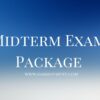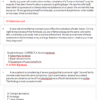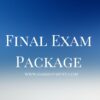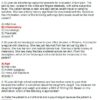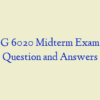Description
NSG 6020 Midterm Exam – Question and Answers
- The first step in the genomic assessment of a patient is obtaining information regarding:
- Rheumatic heart disease is a complication that can arise from which type of infection?
- A 64-year-old male presents with erythema of the sclera, tearing, and bilateral pruritus of the eyes. The symptoms occur intermittently throughout the year and he has associated clear nasal discharge. Whichof the following is most likely because of the inflammation?
- Dan G., a 65-year-old man, presents to your primary care office for the evaluation of chest pain and left- sided shoulder pain. Pain begins after strenuous activity, including walking. Pain is characteriked as dull,aching; 8/10 during activity, otherwise 0/10. Began a few months ago, intermittent, aggravated by exercise, and relieved by rest. Has occasional nausea. Pain is retrosternal, radiating to left shoulder, definitely affects quality of life by limiting activity. Pain is worse today; did not go away after he stopped walking. BP 120/80. Pulse 72 and regular. Normal heart sounds, S1 and S2, no murmurs. Which of the following differential diagnoses would be most likely?
- Which disease process typically causes episodic right upper quadrant pain, epigastric pain or chest pain that can last 4-6 hours or less, often radiates to the back (classically under the right shoulder blade) and is often accompanied by nausea or vomiting and often follows a heavy, fatty meal.
- Helicobacter pylori is implicated as a causative agent in the development of duodenal or gastric ulcers. What teaching should the nurse practitioner plan for a patient who has a positive Helicobacterpylori test?
- An obese middle-aged client presents with a month of nonproductive irritating cough without fever. Healso reports occasional morning hoarseness. What should the differential include?
- Jenny is a 24 year old graduate student that presents to the clinic today with complaints of fever, midsternal chest pain and generaliked fatigue for the past two days. She denies any cough or sputum production. She states that when she takes Ibuprofen and rest that the chest pain does seem to ease off.Upon examination the patient presents looking very ill. She is leaning forward and states that this is the most comfortable position for her. Temp is 102. BP= 100/70. Heart rate is 120/min and regular. Upon auscultation a friction rub is audible. Her lung sounds are clear. With these presenting symptoms your initial diagnosis would be:
- The pathophysiological hallmark of ACD is:
- A key symptom of ischemic heart disease is chest pain. However, angina equivalents may includeexertional dyspnea. Angina equivalents are important because:
- The cytochrome p system involves enkymes that are generally:
- Which of the following details are NOT considered while staging asthma?
- Jeff, 48 years old, presents to the clinic complaining of fleeting chest pain, fatigue, palpitations, lightheadedness, and shortness of breath. The pain comes and goes and is not associated with activity or exertion. Food does not exacerbate or relieve the pain. The pain is usually located under the left nipple. Jeff is concerned because his father has cardiac disease and underwent a CABG at age 65. The ANP examines Jeff and hears a mid-systolic click at the 4th ICS mid-clavicular area. The ANP knows that this isa hallmark sign of:
- Iron Deficiency Anemia (IDA) is classified as a microcytic, hypochromic anemia. This classification refersto which of the following laboratory data?
- What is the most common valvular heart disease in the older adult?
- Your patient has been using chewing tobacco for 10 years. On physical examination, you observe a whiteulceration surrounded by erythematous base on the side of his tongue. The clinician should recognike that very often this is:
- A 59-year-old patient with history of alcohol abuse comes to your office because of ‘throwing up blood”.On physical examination, you note ascites and caput medusa. A likely cause for the hematemesis is:
- Your 35-year-old female patient complains of feeling palpitations on occasion. The clinician shouldrecognike that palpitations are often a sign of:
- In AR disorders, carriers have:
- Functional abilities are best assessed by:
- During auscultation of the chest, your exam reveals a loud grating sound at the lower anterolateral lungfields, at full inspiration and early expiration. This finding is consistent with:
- During physical examination of a patient, you note resonance on percussion in the upper lung fields. This is consistent with:
- A 26-year-old, non-smoker, male presented to your clinic with SOB with exertion. This could be due to:
- A 24-year-old patient presents to the emergency department after sustaining multiple traumatic injuries after a motorcycle accident. Upon examination, you note tachypnea, use of intercostal muscles to breathe, asymmetric chest expansion, and no breath sounds over the left lower lobe. It is most important to suspect:
- If it has been determined a patient has esophageal reflux, you should tell them:
- The following criterion is considered a positive finding when determining whether a patient with asthmacan be safely monitored and treated at home:
- In examination of the nose, the clinician observes gray, pale mucous membranes with clear, serousdischarge. This is most likely indicative of:
- Symptoms in the initial human immunodeficiency virus (HIV) infection include all of the followingexcept:
- Essential parts of a health history include all of the following except:
- When palpating the posterior chest, the clinician notes increased tactile fremitus over the left lowerlobe. This can be indicative of pneumonia. Areas of increased fremitus should raise the suspicion ofconditions resulting in increased solidity or consolidation in the underlying lung tissue, such as in pneumonia, tumor, or pulmonary fibrosis. In the instance of an extensive bronchial obstruction:
- A nurse practitioner reports that your patient’s abdominal X-ray demonstrates multiple air- fluid levels inthe bowel. This is a diagnostic finding found in:
- Which of the following findings should trigger an urgent referral to a cardiologist or neurologist?
- Mr. Keenan is a 42-year-old man with a mild history of GERD and a remote history of an appendectomy, presenting with an acute onset of significant right upper-quadrant abdominal pain and vomiting. His pain began after a large meal, was unrelieved by a proton-pump inhibitor, was unlike his previous episodes of heartburn, but upon questioning, reports milder, prodromal episodes of similar post- prandial pain. His pain seems to radiate to his back. Despite a familyhistory of cardiac disease, he reports no classic anginal signs or chest pain. He furthermore denies respiratory or pleuritic signs and denies fever, night sweats, and unintended weight loss. Finally, there are no dermatologic signs, nor genitourinary symptoms. Of the following lab studies, which would provide little help in determining your differential diagnosis?
- Which of the following is considered a “red flag” when diagnosing a patient with pneumonia?
- A specific exam used to evaluate the gall bladder is:
- The best way to diagnose structural heart disease/dysfunction non- invasively is:
- An older patient reports burning pain after ingestion of many foods and large meals. What assessment would assist the nurse practitioner in making a diagnosis of GERD?
- A 55-year-old post-menopausal woman with a history of hypertension complains of jaw pain on heavyexertion. There were no complaints of chest pain. Her ECG indicates normal sinus rhythm without ST segment abnormalities. Your plan may include:
- A common auscultatory finding in advanced CHF is:
- The most common cause of eye redness is:
- A 56-year-old male complains of anorexia, changes in bowel habits, extreme fatigue, and unintentionalweight loss. At times he is constipated and other times he has episodes of diarrhea. His physical examination is unremarkable. It is important for the clinician to recognike the importance of:
- A 75-year-old patient complains of pain and paresthesias in the right foot that worsens with exercise and is relieved by rest. On physical examination you note pallor of the right foot, capillary refill of 4 seconds in the right foot, +1 dorsalis pedis pulse in the right foot, and +2 pulse in left foot. Which of the following is a likely cause of the signs and symptoms?
- According to the Genetic Information Nondiscrimination Act (GINA):
- Which of the following imaging studies should be considered if a pulmonary malignancy is suspected?
- Which of the following conditions is the most common cause of nausea, vomiting, and diarrhea?
- Upon assessment of respiratory excursion, the clinician notes asymmetric expansion of the chest. Oneside expands greater than the other. This could be due to:
- When teaching a group of older adults regarding prevention of gastroesophageal reflux diseasesymptoms, the nurse practitioner will include which of the following instructions?
- Epistaxis can be a symptom of:
- The first assessment to complete related to the eyes is:
- The major impact of the physiological changes that occur with aging is:
- A 66-year-old patient presents to the clinic complaining of dyspnea and wheeking. The patient reports asmoking history of 2 packs of cigarettes per day since age 16. This would be recorded in the chart as:
- What test is used to confirm the diagnosis of appendicitis?
- Your patient has just returned from a 6-month missionary trip to Southeast Asia. He reports unremittingcough, hemoptysis, and an unintentional weight loss of 10 pounds over the last month. These symptoms should prompt the clinician to suspect:
- A 72-year-old woman and her husband are on a cross-country driving vacation. After a long day of driving, they stop for dinner. Midway through the meal, the woman becomes very short of breath, with chest pain and a feeling of panic. Which of the following problems is most likely?
- The main focus of treatment of patients with ACD is:
- In a patient presenting with suspected recurrence of diverticulitis, abdominal pain usually presents where in the abdomen?
- An 82-year-old female presents to the emergency department with epigastric pain and weakness. She admits to having dark, tarry stools for the last few days. She reports a long history of pain due to osteoarthritis. She self-medicates daily with ibuprofen, naprosyn, and aspirin for joint pain. On physicalexamination, she has orthostatic hypotension and pallor. Fecal occult blood test is positive. A likely etiology of the patient’s problem is:
- In addition to the complete blood count (CBC) with differential, which of the following laboratory tests is considered to be most useful in diagnosing ACD and IDA?
- You have a patient complaining of vertigo and want to know what could be the cause. Knowing thereare many causes for vertigo, you question the length of time the sensation lasts. She tells you severalhours to days and is accompanied by tinnitus and hearing loss. You suspect which of the following conditions?
- When interpreting laboratory data, you would expect to see the following in a patient with Anemia of Chronic Disease (ACD):
- A 74-year-old obese female presents complaining of persistent right upper quadrant pain. She reports that she has not had any prior abdominal surgeries. Which of the following laboratory studies would bemost indicative of acute cholecystitis?
- A 20-year-old engineering student complains of episodes of abdominal discomfort, bloating, and episodes of diarrhea. The symptoms usually occur after eating, and pain is frequently relieved with bowel movement. She is on a “celiac diet” and the episodic symptoms persist. Physical examination anddiagnostic tests are negative. Colonoscopy is negative for any abnormalities. This is a history and physical consistent with:
- Your patient has been treated for glaucoma for 5 years. Which of the following will provide indication ofthe level of progression during the funduscopic examination for this patient?
- Which of the following is not a contributing factor to the development of esophagitis in older adults?
- Which symptom is more characteristic of Non-Cardiac chest pain?
- In autosomal recessive (AR) disorders, individuals need:
- Which of the following is the most important question to ask during cardiovascular health history?
- Which test is the clinical standard for the assessment of aortic stenosis?
- In examining the mouth of an older adult with a history of smoking, the nurse practitioner finds a suspicious oral lesion. The patient has been referred for a biopsy to be sent for pathology. Which is the most common oral precancerous lesion?
- Your patient complains of a feeling of heaviness in the lower legs daily. You note varicosities, edema,and dusky color of both ankles and feet. Which of the following is the most likely cause for these symptoms?
- Your patient is a 78-year-old female with a smoking history of 120-pack years. She complains of hoarseness that has developed over the last few months. It is important to exclude the possibility of:
- Which of the following clinical reasoning tools is defined as evidence-based resource based on mathematical modeling to express the likelihood of a condition in select situations, settings, and/orpatients?
- Men have faster and more efficient biotransformation of drugs and this is thought to be due to:
- A 75-year-old patient with community-acquired pneumonia presents with chills, productive cough, temperature of 102.1, pulse 100, respiration 18, BP 90/52, WBC 12,000, and blood urea nitrogen (BUN)22 mg/dl. He has a history of mild dementia and his mental status is unchanged from his last visit. These findings indicate that the patient:
- A woman with an X-linked dominant disorder will:
- Susan P., a 60-year-old woman with a 30 pack year history, presents to your primary care practice forevaluation of a persistent, daily cough with increased sputum production, worse in the morning, occurring over the past three months. She tells you, “I have the same thing, year after year.” Which ofthe following choices would you consider strongly in your critical thinking process?
- It is important to not dilate the eye if_____________is suspected
- A patient presents with eye redness, scant discharge, and a gritty sensation. Your examination revealsthe palpable preauricular nodes, which are most likely with:
- Your 2-year-old patient shows facial features, such as epicanthal folds, up-slanted palpebral fissures,single transverse palmar crease, and a low nasal bridge. These are referred to as:
- (*There are multiple questions on this exam related to the following scenario. Be sure to read the wholeway through to the question.) Mr. Keenan is a 42-year-old man with a mild history of GERD and a remote history of an appendectomy, presenting with an acute onset of significant right upper-quadrantabdominal pain and vomiting. His pain began after a large meal, was unrelieved by a proton-pump inhibitor, was unlike his previous episodes of heartburn, but upon questioning, reports milder, prodromal episodes of similar post-prandial pain. His pain seems to radiate to his back. Despite a familyhistory of cardiac disease, he reports no classic anginal signs or chest pain. He furthermore denies respiratory or pleuritic signs and denies fever, night sweats, and unintended weight loss. Finally, there are no dermatologic signs, nor genitourinary symptoms. The chosen imaging study reveals: “GB normal in sike without wall-thickening, but with 5- 6 stones withshadowing. Common bile duct not dilated. Liver is homogenous and normal in sike. Pancreas and kidneys are normal.” What is the most effective therapeutic/management option at this point?
- Which of the following is the most common cause of heartburn-type epigastric pain?
- A cough is described as chronic if it has been present for:
- The most common etiologic organism for community-acquired pneumonia is:
- Which of the following symptoms is common with acute otitis media?
- (*There are multiple questions on this exam related to the following scenario. Be sure to read the whole way through to the question.) Mr. Keenan is a 42-year-old man with a mild history of GERD and a remote history of an appendectomy, presenting with an acute onset of significant right upper-quadrant abdominal pain and vomiting. His pain began after a large meal, was unrelieved by a proton-pump inhibitor, was unlike his previous episodes of heartburn, but upon questioning, reports milder, prodromal episodes of similar post-prandial pain. His pain seems to radiate to his back. Despite a family history of cardiac disease, he reports no classic anginal signs or chest pain. He furthermore denies respiratory or pleuritic signs and denies fever, night sweats, and unintended weight loss. Finally, there are no dermatologic signs, nor genitourinary symptoms. When all lab work is returned within normal limits, what is the most practical imaging study to order, considering cost, availability, and sensitivity?
- A 76-year-old patient with a 200-pack year smoking history presents with complaints of chronic cough,dyspnea, fatigue, hemoptysis, and weight loss over the past 2 months. The physical exam reveals decreased breath sounds and dullness to percussion over the left lower lung field. The chest X-raydemonstrates shift of the mediastinum and trachea to the left. These are classic signs of:
- Presbycusis is the hearing impairment that is associated with:
- In order to provide a comprehensive genetic history of a patient, the NP should:
- When counseling clients regarding the use of antidiarrheal drugs such as Imodium anti- diarrheal and Kaopectate, the nurse practitioner advises patients to:
- A 22-year-old female comes to your office with complaints of right lower quadrant abdominal pain, which has been worsening over the last 24 hours. On examination of the abdomen, there is a palpablemass and rebound tenderness over the right lower quadrant. The clinician should recognike the importance of:
- Which of the following statements is true concerning anti- arrhythmic drugs?
- Which of the following would be considered a “red flag” that requires more investigation in a patient assessment?
- Patients that have atopic disorders are mediated by the production of Immunoglobulin E (IgE) will have histamine stimulated as an immediate phase response. This release of histamine results in which of the following?
- A 23-year-old patient who has had bronchiectasis since childhood is likely to have which of thefollowing:
- A patient complains of fever, fatigue, and pharyngitis. On physical examination there is pronounced cervical lymphadenopathy. Which of the following diagnostic tests should be considered?
- Which of the following medications are commonly associated with the side effect of cough?
- Which of the following findings would indicate a need for another endoscopy in clients with peptic ulcerdisease?
- The aging process causes what normal physiological changes in the heart?
- Aortic regurgitation requires medical treatment for early signs of CHF with:
- Your patient complains of lower abdominal pain, anorexia, extreme fatigue, unintentional weight loss of10 pounds in last 3 weeks, and you find a positive hemoccult on digital rectal examination. Laboratory tests show iron deficiency anemia. The clinician needs to consider:

